Category — Writing
There is no me without you
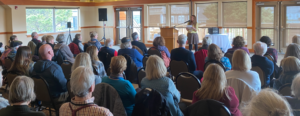
There is no me without you.
There are no writers without readers. There are no writers without booksellers. There are no writers without librarians.
You make what I do possible.
And by “what I do,” I do not mean the act of writing. I make that possible. I mean the ability to reach people with my work.
I know, and have written many times and have told aspiring writers many times, “A real writer is one who really writes.” That’s from a Marge Piercy poem I can recite by heart. What she means is that publication is not what makes a writer a writer. Being a writer is defined by the way you see the world, the way you use writing to figure out that world, what’s important, what makes sense, what you think.
And Piercy may also have been alluding to the “flow state,” that time—minutes, hours if you are lucky—when you (the writer, the artist, the baker, the gardener, the athlete) are so divinely focused on the act of creation that you live outside of time, when all that exists in that moment is the doing. The “justification” for writing is writing.
But then, for me, there is being heard (read). There is hoping what I have discovered, what people have shown and told me, what I have come to understand might resonate, might spark questions and discussion and maybe even action.
And so, for me, readers, booksellers, librarians, arts and letters organizations, and gatherings like the one I was part of this past weekend matter. A lot.
This past weekend I was one of four writers at GetLit at the Beach. No, not a writers’ retreat or a series of workshops. No, not a convention or highly orchestrated bookfest. It was instead a thoughtful, organized but somewhat freewheeling, high-energy three-day event designed for bibliophiles, the brainchild of Terry Brooks. That’s Terry Brooks, the fantasy fiction author with 23 New York Times bestsellers to his name. For the record, he is a self-effacing, down-to-earth, generous man, a sweetheart, actually.
And the event, from the opening reception on one of those glorious blue-sky days at the Oregon coast to the spirited closing panel discussion with rain pelting down (we were inside, of course), was…searching for words here: invigorating, empowering, exciting. Food for the soul. I left feeling proud–not of myself, but of the GetLit folks and Cannon Beach Book Company and the Tolovana Arts Colony and readers, readers, readers.
I am back, ready to work.
And the “me without you” begins with the support, encouragement, passion, perseverance and HARD WORK of Heather Jackson.
April 19, 2023 No Comments
What’s behind the curtain
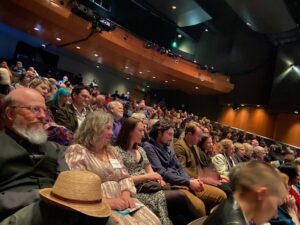
No. I swear to you. This is not more self-promotion about the Oregon Book Award—although the life of the not-already-famous-with-massive-“platform”-writer (that would be me) has been overtaken by, swamped by, self-promotion. I wrote about this for Nieman Storyboard. And struggle with the tension between DOING the work and blabbing about the fact that I have done the work. And angsting about followers and likes and shares and reels and stories and how long I can ignore TikTok and what the New Big Thing will be that will suck up my time.
Instead, I want to pull back the curtain on what, to you all (not you writers reading this…you know the hard truth of this…) may look like “success.” I am talking about the (wonderful, gratifying) Oregon Book Award. Btw, that mention (now twice in two paragraphs) is good seo. For those of you blessed to not know what this is, it stands for Search Engine Optimization, the process of improving the quality and quantity of website traffic to a website or a web page from search engines. So, the more times I mention Oregon Book Award (see how I did that!), the better the chance that this little essay will show up when someone Googles that phrase.
Little man behind the curtain time. My experienced, smart, well connected, caring, and hard-working agent did not have an easy time finding a home for Free. It is not an easy sell. It is not an easy topic. Sure, people OUGHT to care. Sure, there SHOULD be ongoing community and national conversations about how to help people returning home from prison make meaningful lives for themselves. And, yes, the “low-hanging fruit” (criminal justice reformers and activists and the like-minded) may want to read a book like Free. But that, tragically—and I use that word advisedly—is a small group. So, a big publisher with clout and power in the literary marketplace was not going to embrace this book. And did not. It did not help that the previous book was about an even tougher-to-sell subject, life as it is lived by those who’ve been incarcerated for most of their lives.
The paperback. For my entire writing life, the paperback edition of a book follows the hardback by about a year. Standard. Paperback gives the book new life. Often paperback covers are redesigned to give a refresh. Book clubs love paperbacks and often wait for that edition. This publisher has no plans to publish a paperback edition until they sell more hardbacks. But hardbacks have a very limited life. Whatever promotion was done when the book was launched back in May of last year is it. And of course, there is the used book market, which kinda takes over after six months. That’s why paperbacks jump in to reinvigorate. Will the Oregon Book Award (yes, I did it again) make a difference? Who knows. And I don’t have the bandwidth to care as I direct my energies to my next book. What I do know this:
The real writer is one who really writes.
Work is its own cure.
You have to like it better than being loved.
(excerpted from a Marge Piercy poem)
Well, it’s nice to be loved too.
*image (mine) Packed house at Portland Center Stage/ Armory for Oregon Book Awards event April 3, 2023.
April 5, 2023 7 Comments
The happy writer. Really?

Can we write our way to happiness?
On first blush this question oozes self-indulgence and privilege. More woo-woo bullshit.
On second blush, “can we write our way to happiness?” could be the rhetorical tagline for those enticing writers’ workshops in Tuscany.
But there is actually a body of scientific research on the health and mood benefits of writing and rewriting one’s one narrative. (Google “expressive writing and health” for many citations.) There is significant research on story-crafting and behavior.
We all have a personal narrative that shapes our view of ourselves and the world(s) in which we live. We create that narrative. We construct stories out of experience. We listen to others tell us about ourselves. We learn–even if we don’t think we are learning, even if we don’t want to– what is expected, what is acceptable, and how we fit (do not fit) in. Over time, a grand narrative emerges. And we recite it to ourselves. Over and over. We believe it. We inhabit it. For some, this can be harmful, limiting, even debilitating.
What if we wrote it out this story. Looked at it. And then learned to tell another plausible tale, an alternative narrative, based on the same information.
That’s what researchers at Duke University did with a group of freshmen who (because of bad grades) told themselves they were losers, that they were unfit for college. That was their narrative. These students underwent a “story-changing intervention” during which they got information (and were exposed to inspirational videos) about students who struggled during freshman year but improved as they adjusted to college. The “loser freshman” story could then be recast into an upward trajectory, “this is just all part of growth and adjustment” story. And guess what? Students who had been prompted to change their personal stories improved their grades and were far less likely to drop out than the control group with no intervention.
I thought about the notion of writing one’s way to a more positive self-image, a healing place, an invigorating place, a place of power and self-worth every time I sat with my writing group at Oregon State Penitentiary. They were all serving life sentences for murder. To move beyond debilitating shame and endless guilt, they wrote about the men they were learning to become, the men they had become. They were changing the narrative of their lives.
I think about the woman in my recent university seminar, emotionally brutalized at one of those “bad teen” bootcamps, who is, more than a very tough decade later, writing her way to stability and health. I think about the women in the workshops I am now teaching who use writing as a way to process the pain they have tried so long to ignore.
It is talk therapy when you do the talking. It works.
March 15, 2023 3 Comments
Camino magic
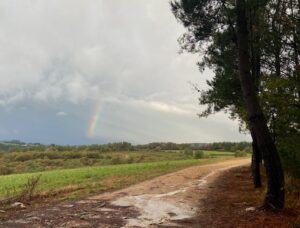
A charming man from the Netherlands operated a tiny tienda next to the albergue in Larrasoaña, my third stop on the Camino Frances. I ordered a café con leche at his place and listened, for the better part of an hour, to his stories. He had walked the Camino thirteen times, he told me. His stories had the air being oft-told, so it is possible that, over time, he had embroidered a bit. It seemed he had created a legend, modest though it was, around himself.
Nevertheless, I listened with great curiosity because I could not imagine why, with all the places in the world to explore, with all the extraordinary hikes through extraordinary landscapes, this guy would choose to walk the same 490 miles thirteen times. As I walked on, I met other repeat Camino pilgrims. Or heard first-timers vow they would return.
It was a mystery to me, this urge to repeat, this do-over mentality. Oh yes, the countryside was extraordinary as the path meandered across undulating plains, roamed through olive groves and vineyards, ventured across both arid flatlands and green rolling hills; as it traversed the cobblestone Calle Major of tiny villages both quaint and (no other way to say this) sorry-ass. The experience was extraordinary, a potent and often unexpected ping-ponging between daily grind and dazzling revelation. But do it again? And again?
Now more than three months since I returned from my trek, I think I understand. I think it is because those Camino lessons in simplicity, focus and clarity, in what matters and what doesn’t, in the camaraderie of souls, in delighting in the ebb and flow of life, those lessons learned while walking, those lessons you told yourself you’d never forget…they are damned hard to hold on to.
I remember thinking, so very many nights, sleeping between paper sheets or in a bunkbed or in a room of snorers “I’ll never take my quiet bedroom with my big bed and my flannel sheets for granted.” And then I did. Within days. ”I’ll never take an evening in front of the fire reading a book for granted.” And then I did. “I’ll never forget that you can be independent and interdependent simultaneously, that receiving help and being helpless are not at all the same, that things make sense when you stop trying so hard to make them make sense.” How to hold onto all this?
I think people walk again and again to recapture these moments, to relearn the lessons, to sink back into the magic. That’s what I am attempting with my writing.

February 8, 2023 8 Comments
The author as relentless self-promoter

This essay appeared in Nieman Storyboard today. Click to see or read below.
It was the mid-1990s. I was sitting across a white damask table-clothed table at a midtown Manhattan steak house watching my editor, Bob Loomis, alternately cut into a ribeye and sip a dry Martini. This was it, and I didn’t even know it.
Loomis was then a septuagenarian, a very much living legend in the world of publishing, a man who had edited the likes of Maya Angelou, William Styron, and Calvin Trillin I didn’t know this at the time. I didn’t Google him because Google didn’t exist. I didn’t look him up in Wikipedia because there was no Wikipedia. What I knew is that I had a contract for my first book, “Stubborn Twig,” with Random House. What I knew was that an impressive older man in an expensive suit was taking me out for a pricey lunch and treating me like a was somebody.
In truth, I was nobody. So I put my shoulder to the wheel and wrote the hell out of the book, benefitting immensely from Bob Loomis’ frequent phone calls and quietly brilliant edits and queries (in pencil in the margins of my hard-copy manuscript). Three years later, when the book launched, it was greeted with reviews in more than a dozen newspapers. That was when so many newspapers had weekly book review sections. Meanwhile my publicity person sent me a multi-page itinerary that listed the bookstore events that had been arranged for me, along with my travel schedule, the hotels where I would stay and the names of the handlers that would be chauffeuring me around in each city.
All that, even though I was not a young, hot debut novelist. I was not a household word — even in my own household. I was simply getting the treatment that book authors got. I didn’t know it then, but I had gained entry to a world that would soon disappear. And my subsequent life as a writer would change in ways I could never have imagined back then and still struggle to imagine even as I am living that life.
The author as DIY marketing department
This is my life as a nonfiction author now:
“Free: Two Years, Six lives and the Long Journey Home,” my eleventh book of narrative nonfiction, launched this spring. I have never met my editor in person. The only sustained conversation I have had with her was early on, pre-contract, when we were sussing out each other. Her Track Change notes and edits in Word.doc were fine but minimal.
This is not because I am now such a great writer that I no longer need a great editor. It is, I believe, because many of today’s editors have decades less experience than the editors of yesteryear, lower standards — I am now routinely praised for merely delivering a manuscript on deadline — and less time to devote to each project. My agent (a true gem and, not incidentally, an erstwhile “editor of yore”) offered the most insightful comments.
When the manuscript was in the process of becoming a book, I did what editors of yore used to take care of: I wrote the copy for the flap and back of the book. I went begging my writer friends for endorsement blurbs, followed up with near-desperate pleas, extracted pull-quotes from their generous responses, then compiled and sent these to the editor. I spent countless hours researching award-winning book covers, sending images, color palettes and type fonts to my editor. I took this on because I had learned that out-sourced illustrators had most often not read the book they were assigned to illustrate and had, as outsiders, not been part of any editorial discussions.
When it came to the title of the book, however, I lost the control I had always had. The marketing department took over. My agent and I had to mount a concerted effort to secure a title we could live with.
This extra work might be considered part of, or at least connected to, the writing process. But there is so much more to being an author now, and by “now” I mean for at least the last decade. For those who have visions of being the courted and cared for, that woman at the midtown Manhattan steakhouse, the cherished writer who flourishes within the brilliant, clever, commanding, and attentive world of commercial publishing: Sorry. No.
Blogs, tweets and favors from friends
What follows is a chronicle of some of the many responsibilities I — and most authors — shoulder today, the jobs we now must do, the tasks that fall to us if we want to see our work have a chance of success. If this sounds like whining, it sort of is. But as I whine, please know that I am conscious of the extraordinary privilege of voice. I am conscious of the privilege of being able to practice my craft, even if it means, as I heard a fellow journalist-turned-author lament the other day: relentless self-promotion.
The “cover reveal.” When the cover for the book was finalized — note my use of passive voice as there were three rounds of (to me) opaque market-testing going on that determined the final decision — it was time for me to start promoting the book. The book would not be published for months, but revealing the cover was an “opportunity” to gin up excitement and get people to pre-order. To be clear: I loved the cover. We, my agent and I, went to the mattresses (as Sonny Corleone put it) to get the cover we loved. But the point of revealing it (across all my social channels…more on this in a moment) was not to revel in the design but to offer a one-click option to pre-order. Pre-orders matter. A lot.
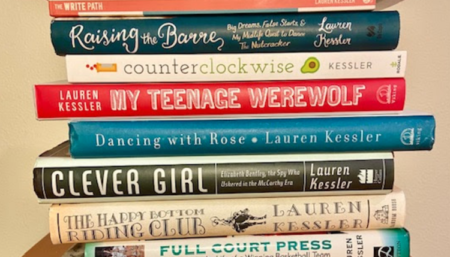 The blog slog. I created a book-centric blog back in 2011 when “My Teenage Werewolf: A Mother, A Daughter, A journey through the Thicket of Adolescence” was first published. I did this because, even after I was finished reporting and writing the book, my research into the mother-daughter relationship did not end. I wanted to share it. I did the same thing with my next book, “Counterclockwise,” which was my immersive investigation into the hope of the science of aging and the hype of the “anti-aging” movement. There was so much new research coming out and so much Internet-fueled garbage that I had to find a way to keep writing about the subject.
The blog slog. I created a book-centric blog back in 2011 when “My Teenage Werewolf: A Mother, A Daughter, A journey through the Thicket of Adolescence” was first published. I did this because, even after I was finished reporting and writing the book, my research into the mother-daughter relationship did not end. I wanted to share it. I did the same thing with my next book, “Counterclockwise,” which was my immersive investigation into the hope of the science of aging and the hype of the “anti-aging” movement. There was so much new research coming out and so much Internet-fueled garbage that I had to find a way to keep writing about the subject.
But all this subject-specific blogging was not, alas, helping to develop (and elevate) my platform, my (to quote from masterclass.com) “ability to market (my) work, using (my) overall visibility to reach a target audience of potential readers.” I was blogging to make new information available to those who might be interested. I was not blogging then to promote these books or to create a (Yes, I will use the B word. ) “brand” for myself.
Enter my now-branded blog (www.laurenchronicles.com) in which I labor to maintain my integrity while also creating thinly veiled promotional posts leading up to publication and during the important two to three months that follow. Because I am a writer who blogs and not a blogger who writes, I spend upwards of three hours crafting these 400-word posts, each a self-contained essay, ending with the implied or stated BUY THIS BOOK. I post links to the essay on my personal and author Facebook pages. I tweet it out. I try to figure out how to engage the largely visual audience that follows Instagram and mostly “likes” images of cats sunning themselves. Just in the last two weeks, I have spent more than a full workday creating reels for Instagram.
The maw of social media. I post. A lot. Much of it is book-related. I try — but I do not always succeed — to avoid those cringe-worthy “humble brag” posts ubiquitous on social media. (I am humbled by this glowing review of my new book… Humility? Really?) While I am on all these channels, I must pay close attention to such unwriterly but stunningly important things as optics, hashtags, SEO, followers, page views, bounce rate, device breakdown, referral sources. As part of my platform — without which I could not function in the book publishing world —I created and personally maintain and update my author site, my blogsite, my two Facebook accounts, my Twitter and Instagram feeds, my Amazon author page and my Goodreads page.
Is the tech stuff in my wheelhouse? Well, now it is. Does all this social-ing eat into reporting and writing time? You bet.
That’s why I was thrilled to hear that my “launch team” was going to play a big part in promoting my latest book. I heard this encouraging news during a three-hour webinar presented by my publisher. I have a team! I immediately jumped into chat to ask how I could connect with my team.
The self-launched team. It turns out that it was my responsibility to create this team by personally reaching out to friends, supporters, readers, my social media followers, anyone I knew who might be entreated to beat the drum for my book. I was to invite them to be “part of the team” and suggest different ways they could help: pre-ordering the book, posting pre-publication reviews on Goodreads, bombarding Amazon with five-star reviews the day after publication, liking my posts, sharing my posts, creating their own posts about my book, talking up my book to book groups or organizations they were part of. This would be ongoing communication. Every week I was to email my team with a new idea or a link to my new post or a review or interview that just came out or an announcement of a reading I was doing. I could, it was suggested, make little videos of myself talking excitedly about the book — a personal touch — and send these to the team.
Balancing the privilege and realities of authorship
And there is so much more that occupies me these days, including researching relevant podcasts and creating specific pitches for each; teaching myself how to produce reels for Instagram that are engaging but not silly or snarky; creating YouTube videos; immersing myself in TikTok (because #bookTok) to understand this Thing. And wishing that I was, instead, polishing the proposal for a new book. Wishing instead I was plunging ahead with research and reporting. Wishing I was living the life of a writer and not a self-promoter.
And yet, to live this (very privileged) authorial life, I must, like just about every other author today, spend a significant amount of my time not practicing my craft. Also, like possibly 98 percent of all book authors, I do not make a living wage from my books so must bolster my income and pay for my health insurance with teaching gigs and work-for-hire opportunities.
This is the reality for those of us who are not celebrities or “influencers,” those of us who do not have social media followers measured in the “Ks,” those of us whose life, work and thoughts do not go viral.
You know, we journalists. We who strive to tell important stories too big and too complex to fit into a newspaper article, or even a series. We who stubbornly dream about living the (vanished) life of the writer.
July 13, 2022 3 Comments
The rocky road from caged to free

You’re like a ray of sunshine,” the interviewer told her. And she was. Just released after 17 years in prison, almost giddy with optimism and the promise of a new life, Catherine radiated energy and goodwill. She was focused, articulate, and charming. Her smile was infectious. She was confident but not arrogant, poised but not scripted, warm but entirely professional. Her buoyancy, which might have seemed almost adolescent, was tempered by her composure, a skill born of years navigating a life behind bars, of growing up and coming of age behind bars.
She was 30 years old, but for her this was the start of the life she was determined to live. Her résumé included a two-year college degree and a paralegal certification. Inside prison, she had designed and taught workshops for abused women. She wanted to be a teacher or perhaps a nurse. But first she had to establish herself, find a job that tapped into some of her skills and paid her accordingly so she could establish a work history and save for the future she dreamed of.
After the questioning and the conversation, after the smiles and the compliments, Catherine told the interviewer about her homicide conviction, a crime committed when she was just 13. The woman would find out anyway. Catherine thought that if she told the interviewer right then, in person, within the context of the interview that had just taken place, that person would see her in context. If instead her record was later uncovered during the background check almost all employers conducted these days, the interviewer would think she had tried to hide her past. Her crime, a violent crime, would stun them. They would, she figured, just toss her resume in the trash. So she told the interviewer that day. “We’ll call you,” the woman said.
Catherine, that “ray of sunshine,” waited for a call that never came.
How many interviews were just like that one? What job did Catherine finally get? How many years did it take for her to find the work that would change her life—and the lives of so many others?
I hope you’ll want to read her story, and the reentry stories of five others–their long journeys from caged to free–in my new book Free: Two Years, Six Lives and the Long Journey Home.
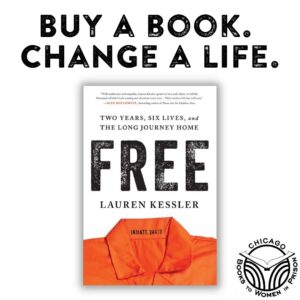
May 25, 2022 No Comments
Out of step, out of time

I met Belinda for the first time toward the end of her twenty-two-year stretch in prison. Back when she was eighteen she had been convicted of stabbing her pimp. She hadn’t meant to kill him, just hurt him. She’d been on the streets since she was fourteen, when her mother stopped the car and told her to get out, and she had learned to take care of herself. Or at least stay alive.
I saw her again the day she was released. It was raining that morning. She was wearing sweat pants a size too large and a cheap nylon jacket, clothes brought in by a friend the day before. She was lit up, like a girl rushing out to meet her prom date.
A month later, Belinda and I sat in a booth at a chain steakhouse where she ordered the most expensive item on the menu plus three extra sides. The food on the plates in front of her could have feed a family of four. Belinda hardly touched it. She had not looked up from her phone since we sat down. A month ago, she had never texted. A month ago she had never held a smartphone in her hand. Now she was nonstop-texting with her thumbs. She had gotten the phone three weeks before. She had acquired a boyfriend a week later. She was in the throes of what sociologists call “asynchronicity.”
While Belinda was in prison, her age cohort moved on. Inside, time was frozen. Outside, other young women acquired (and dumped) boyfriends or girlfriends, went to concerts, got (and lost) jobs, maybe went to college. On the outside, other young women moved to new apartments, new towns, new countries, had adventures, changed their look, had career aspirations that worked out or didn’t. On the outside, other young women grew into their thirties, found their place, lost it, reinvented themselves, settled in. They had children. Inside, Belinda had experienced a lot, but none of this. At forty, she was still in many ways a teenager. She was a teenager with a new phone texting a new boyfriend.
When we think about those being released from prison—that’s more than 600,000 men and women a year–we might wonder: Where will they live? Who will employ them? Will their families welcome them back? Will they end up back behind bars? But for those who have been away from the world for decades like Belinda, the questions are more nuanced. They are, in fact, existential: How will they recalibrate? How will they—out of step, out of time, out of place—find their footing, rejoin their cohort, make sense of their asynchronous lives?
In my new book, Free: Two Years, Six Lives, and the Long Journey Home, I ask these questions (and so many others) as I chronicle the reentry paths of six formerly incarcerated people, men and women, Black, brown and white, as young as thirty, as old as sixty. They allowed me into their complicated lives, alternately joyful and anxious, frenzied and stagnant—and for some, deeply asynchronous.
While Catherine was in prison—the youngest person to be tried as an adult for murder (she was thirteen)—she missed her adolescence, her teens, and her twenties. That may have fueled her marriage inside to a man she never was able to date; her quick connection, once released, to another man; her back-to-back pregnancies; her divorce. There was much catching up to do. She fast-tracked herself.
Trevor and Sterling went inside as teens, emerged as men. Vicki came back to children who had grown up without her. I hope you will want to read about their journeys, not only about the tough challenges and the uphill battles, but also and most especially about the extraordinary resilience that fueled (and continues to fuel) their journeys. I hope it makes you believe in second acts, in second chances.
(fyi: For every copy of Free sold between now and May 27 my publisher, Sourcebooks, will donate a book from their extensive catalog to Chicago Books for Women in Prison, a nonprofit that distributes books to prisons across the country. Purchase from anywhere.

April 13, 2022 4 Comments
Walking the talk

When I started going into prison to run a writers’ group for lifers, I wanted to help the men find their voices and tell their stories, and I also wanted to learn from them about the realities of incarcerated life, that hidden-from-view world inhabited by 2.3 million people in our country. As we talked about the art and craft of writing I kept suggesting books they could read that exemplified the power of nonfiction storytelling. None of those books were in the prison library.
But to be a writer one has to read good writing, yes? And to prepare for freedom one has to be able to practice (and hold dear) intellectual freedom: the opportunity to read books that open new worlds; the chance to write with clarity and passion about the world one currently inhabits.
During the three years the group met, I was able to bring in—volume by volume–quality books about writing techniques along with dozens and dozens of narrative nonfiction books culled from my own library and used bookstores. I had the extraordinary support of a prison staffer. The prison’s furniture shop created a tall wooden cabinet to house the “Writers’ Collection.” One of the men volunteered to be the lending librarian. We bragged about it shamelessly. And they read voraciously.
And now, thanks to a partnership between the publisher of my new book, FREE: Two Years, Six Lives and the Long Journey Home, and the nonprofit Chicago Books to Women in Prison, I get to be involved in helping to build prison libraries on a national scale.
For every copy of FREE sold (it doesn’t matter from what retailer) between April 1 and May 27, Sourcebooks will donate a (different) book to Chicago Books to Women in Prison to distribute free of charge to state prisons in Arizona, California, Florida, Illinois, Indiana, Kentucky, Mississippi and Ohio, as well as all federal prisons.
Their mission statement: “We are dedicated to offering the opportunity for self-empowerment, education and entertainment that reading provides.”
Because BOOKS CHANGE LIVES. (Which just happens to be the motto of my publisher.) And Sourcebooks walks the talk.
FREE is about how people reclaim and remake (and reimagine) their lives after long-term incarceration. I hope the stories I was privileged to tell give realistic hope to those who will someday be free. I hope these stories help families and friends and communities understand how freedom can be simultaneously joyful and overwhelming. I hope these stories bring into focus what it takes to help these folks be successful. What we need to do.
And now I get to hope a new hope: That with this partnership, my book, the sale of my book, will result in thousands of books donated to those behind bars. You can be part of this too.
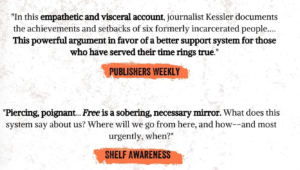
April 6, 2022 4 Comments
I HEART librarians

As a writer, a reader, a bibliophile, one who believes that literacy unlocks countless doors, one who believes that books change lives, I have been a life-long lover of libraries. Especially public libraries.
Brief pause for historical interlude: As with many wonderful ideas that happened a long time ago in this country, Benjamin Franklin figures into the library narrative. He founded the first one in the colonies, a lending library in Philadelphia in 1703. The country’s first free (which is to say, tax supported) public library opened in the spring of 1833 in Petersborough, New Hampshire. The more famous (and erroneously claimed as “first’) Boston Public Library opened its doors in 1852. Fun fact: In the 1890s, the city boosters of Butte, Montana opened that city’s public library “as an antidote to the miners’ proclivity for drinking, whoring and gambling.” (One wonders how that worked out for them.)
A few years later, the millionaire (when that meant something) governor of New York, Samuel Tilden, bequeathed a fortune to establish the extraordinary New York Public Library. And then there was Andrew Carnegie, industrialist-philanthropist, who funded the establishment of more than 2,500 libraries worldwide, 1,689 of them, each a gem, in the U.S. Today, in case you’re interested, we have more than 16,000 public libraries.
And now, back to the present (or, rather, five days ago):
I am signing advance readers’ copies of my soon-to-be published book, Free: Two Years, Six Lives and the Long Journey Home, at the Public Librarians Association annual convention. Sourcebooks, my extraordinary publisher (incidentally, the largest woman-owned publisher in North America) has a booth in the convention hall. There’s a line of librarians queuing up, the badges hanging from their necks identifying them as hailing from Alaska and Arkansas, Wyoming, Arizona, Louisiana, Denver, Boston, all over the Midwest.
In the thirty seconds or so I have to interact with each of them, I ask why they are interested in the book. I’m prepared for the usual answer: Adult nonfiction is a big category for us. I am not prepared for the personal responses: The references to family members or friends who have spent time behind bars and their difficult journeys back to their communities. And I am really not prepared to learn of their professional involvement, as librarians, in the lives of previously incarcerated in their communities.
These librarians see and talk with these folks every day. Some—far too many–who are released from prison are unhoused. On the streets at night, they find refuge during the day at the public library, a warm, dry place to sit, to read, to snooze. And yes, to use the bathroom. Some who are released go to temporary shelters or halfway houses or transitional housing, too often chaotic noisy places that can feel (and be) confusing or unsafe or both. A few hours of quietly sitting, undisturbed, in a public library is a respite.
The librarians I got to meet were on the frontline, aware of and sensitive to the challenges of reentry. More than a few talked about special programs they run or are creating to welcome and serve this population. “We are at the heart of our communities,” one Ohio woman told me. “We serve the entire community—and that means those who’ve spent time in jail and are now back home. We can model that for others.”
Oh librarians, how do I love thee? Let me count the ways.
The book I signed for them, the book you can pre-order now (publication date April 19):
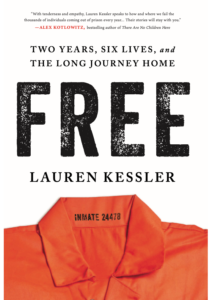
March 30, 2022 19 Comments
You missed me, right?
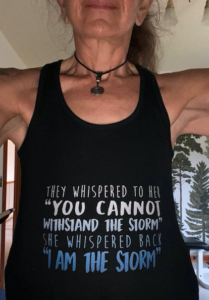
How come you haven’t been posting a little essay at your blog every week as you have for, like, forever? I’ve sure missed it.
Said no one.
But, since you didn’t ask, let me tell you: When I first started blogging 11 years ago—yes, that long ago—it was in support of my then just-about-to-be-released book, My Teenage Werewolf. The weekly posts were meant to gin up interest in the book and, as they say, “build my platform.” Neither of which happened. I then blogged my way through the next book, Counterclockwise, mostly because there was no end to the fascinating research coming out about health and aging, and I wanted to keep sharing it. Then there were the weekly stories connected to my next project, Raising the Barre, which I found time to write because the book was teaching me so much about humility and self-empowerment as I learned about the lives of those who lived their art. Research for the prison book, A Grip of Time, grabbed hold of me and wouldn’t let go, so I had to write about that even as I was writing the book.
But the blog also became a place where I could write about writing and, during those dark Trumpian years, about politics, about holding on to a semblance of sanity, about not losing hope. The weekly stories became part of my writing discipline. I no longer thought about “platform building” or driving sales or–forgive me, I actually had this fantasy back in 2010– “going viral.”
Lately, though, not that you noticed, I have not been posting regularly. Work on the new book, which I hope will be titled Time After Time, has taken over. (Four weeks and counting to manuscript deadline.) Add to that the work-on-top-of-work it has been to conceptualize, refashion and reboot four writing workshops and a graduate seminar to the virtual classroom.
And then there’s the psychic energy drain of living through the final dangerous days of Trump and the never-ending months (now a year) of the pandemic.
Anyways, my friends, I am back. At least for the moment. And while I have your undivided attention (all 3 of you), I wanted to share this link to an interview I did recently with the 1200-member Aviatrix Book Club about The Happy Bottom Riding Club. That book, one of two biographies I’ve written (published, yikes, 20 years ago), has recently—and mysteriously—been getting renewed attention. There’s this book club, and then another female pilot book club before that, and a film option. It’s nice that old books never die. I am reminded of that final scene in The Happy Bottom Riding Club, possibly my favorite in the book. If you know it, you know just what I mean. I am not, however, covered in ashes.

March 3, 2021 4 Comments





